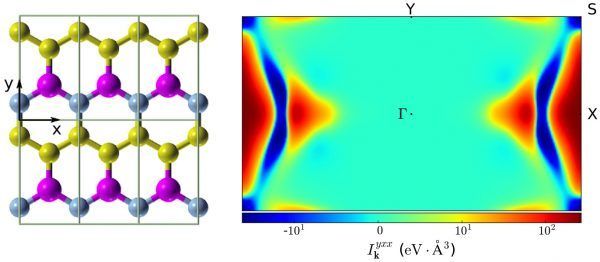Directional shift current in mirror-symmetric BC2N
Ibanez-Azpiroz et al. theoretically describe the shift-current photoconductivity of graphitic BC2N. It is strongly anisotropic near the fundamental gap due to quantum dipole selection rules imposed by mirror symmetry, which imply that the relative parities between valence and conduction bands are key for determining the directionality of the band-edge response.
Quick, manipulable and efficient conversion of light into electricity is key for future clean-energy technologies. The bulk photovoltaic effect, also known as the shift current, is a nonlinear absorption process that converts light into electrical current intrinsically, and has attracted increased attention in recent years due to potential applications in solar cells.
In this work, the authors report a distinctive shift-current response at the band-edge of a noncentrosymmetric polytype of graphitic BC2N, a quasi two dimensional layered semiconductor made of alternating zigzag chains of carbon and boron nitride. They perform accurate density functional theory calculations of the shift photoconductivity employing a recently developed formalism based on Wannier interpolation.
The group’s ab initio calculations show that near the fundamental band gap the calculated response exhibits strong anisotropy, due to the vanishing of certain tensor components not foretold by phenomenological symmetry arguments. They trace the origin of this anisotropy to the mirror symmetry of the crystal, which imposes quantum selection rules on dipole transitions between the valence and conduction bands near the fundamental band gap. In addition to the density functional theory analysis, the researchers also capture the essential physics of this phenomenon with a two-band k · p model, thus providing a suitable framework for a broad class of materials.

Figure: (Left) Crystal structure of one layer of BC2N, where magenta, grey and yellow balls represent boron, nitrogen and carbon atoms, respectively. (Right) Heatmap plot across the 2D Brillouin zone at kz = 0 of the yx matrix element of the shift photoconductivity.



